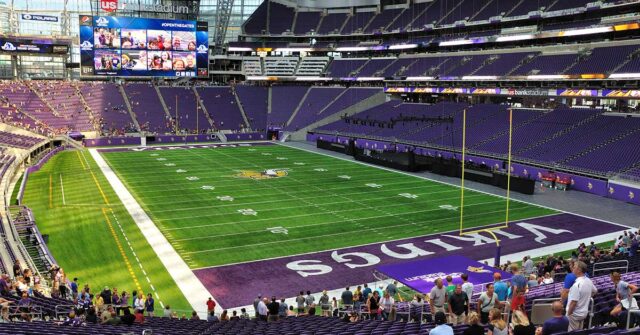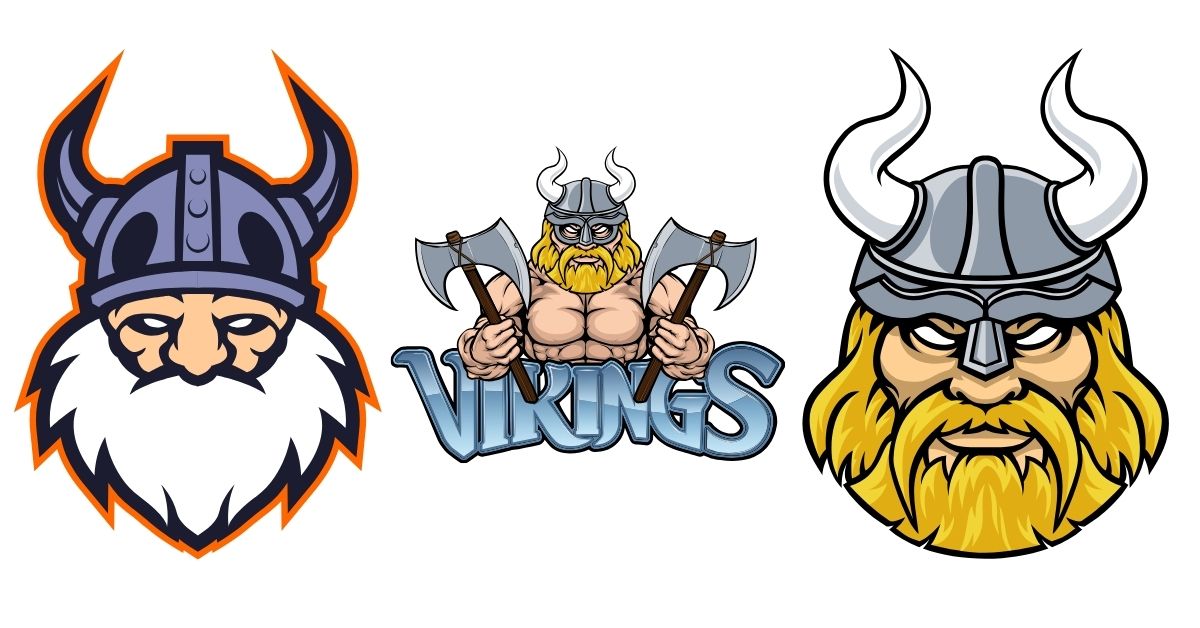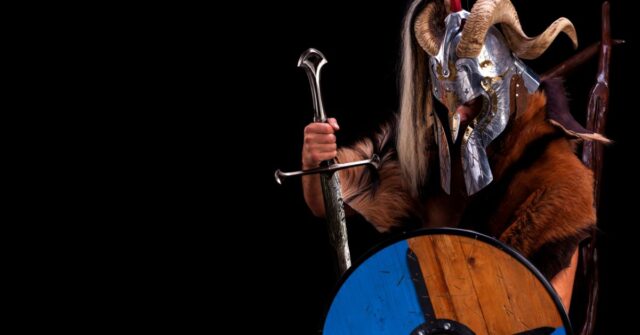Viking imagery has long been a staple in the branding of sports teams and mascots, conjuring images of fierce warriors and adventurous seafarers.
This blog post delves into the reasons behind the popularity of Viking imagery, its historical context, and its impact on fans and communities.
We’ll also explore how it compares to other cultural symbols used in sports and address the ongoing debates surrounding these representations.
Introduction
The use of cultural symbols in sports teams’ branding can be a powerful tool, evoking specific qualities and emotions.
Viking imagery, with its connotations of strength, bravery, and resilience, is particularly popular.
This post aims to explore the reasons for this popularity and the implications it has for fans, communities, and the broader cultural landscape.

The Popularity of Viking Imagery in Sports
Viking imagery is widely used in sports for its strong visual appeal and the values it represents.
Teams adopt Viking symbols to convey a sense of toughness, adventure, and competitive spirit. This section explores why these images resonate so well with sports teams and fans alike.
Historical Context
Viking imagery stems from the history of the Norse people, who were known for their seafaring expeditions, exploration, and warrior culture from the late eighth to early eleventh centuries.
These historical figures were not only feared for their raids but also respected for their navigation skills and resilience.
The romanticized view of Vikings as fearless and formidable warriors makes them ideal symbols for sports teams aiming to project strength and determination.
Modern Appeal
In contemporary times, Viking imagery continues to captivate audiences due to its association with popular culture, including movies, TV shows, and literature.
The enduring fascination with Viking mythology and history keeps these symbols relevant.
Sports teams leverage this appeal to engage fans and create a distinct identity that stands out in the competitive world of sports branding.
Iconic Sports Teams with Viking Imagery
Several sports teams have successfully incorporated Viking imagery into their branding, achieving both visual impact and cultural resonance.
This section highlights some of the most notable examples.
Minnesota Vikings (NFL)
The Minnesota Vikings are perhaps the most famous example of a team using Viking imagery.
Established in 1960, the team’s name and mascot were chosen to reflect the state’s significant Scandinavian heritage.
The logo features a Viking warrior with a horned helmet, emphasizing bravery and combat prowess.
The team’s branding reinforces these traits, fostering a strong connection with fans who take pride in this fierce identity.

Other Notable Teams
Other sports teams around the world have adopted Viking imagery, including local and amateur teams.
These teams often use Viking names, logos, and mascots to create a strong and memorable brand that conveys their competitive spirit and determination.
Symbolism and Attributes of Viking Imagery
The symbolism behind Viking imagery is rich and multifaceted, encompassing various attributes that make it appealing for sports branding.
This section delves into the key traits associated with Vikings and how they translate into sports culture.
Strength and Bravery
Vikings are often depicted as paragons of physical strength and bravery. These qualities are essential in sports, where teams strive to showcase their prowess and fearless nature.
Viking symbols help teams project an image of invincibility and courage, rallying both players and fans around these powerful traits.
Resilience and Endurance
The resilience and endurance of Vikings, who endured harsh climates and challenging voyages, resonate with sports teams that value perseverance.
This imagery serves as a metaphor for the relentless pursuit of victory, encouraging athletes to push through adversity and maintain their fighting spirit.
Warrior Spirit
The warrior spirit of the Vikings, characterized by their readiness for battle and strategic mindset, aligns well with the competitive nature of sports.
Teams adopting Viking imagery often emphasize these aspects to highlight their tactical approach and unyielding determination to succeed.
Comparing Viking Imagery with Other Cultural Symbols in Sports
While Viking imagery is popular, it is not the only cultural symbol used in sports branding.
This section compares Viking imagery with other cultural symbols to highlight similarities and differences.

Native American Imagery
Native American imagery has been widely used in sports but has faced significant controversy due to its cultural sensitivity.
Unlike Viking symbols, which represent a historical and extinct culture, Native American mascots can perpetuate harmful stereotypes and disrespect living communities.
The debate over these symbols is ongoing, with many teams opting to change their mascots to avoid offending Native groups.
Roman and Greek Imagery
Roman and Greek imagery, featuring gladiators and mythical figures, is also popular in sports branding.
These symbols convey strength, honor, and a rich historical legacy, much like Viking imagery.
However, they do not carry the same contemporary cultural significance as Native American symbols, making them less controversial and widely accepted.
Other Historical Cultures
Sports teams sometimes use symbols from other historical cultures, such as medieval knights or samurai warriors.
These symbols are chosen for their association with bravery, honor, and combat skills.
While they share similarities with Viking imagery, each symbol brings unique historical and cultural connotations that appeal to different audiences.
Cultural Sensitivity and Controversies
Using cultural symbols in sports can be contentious, particularly when it involves living cultures.
This section explores the controversies and cultural sensitivities related to these symbols, with a focus on Native American imagery.
The Debate Over Native American Mascots
Native American mascots have been a point of contention for decades. Critics argue that these mascots perpetuate stereotypes and disrespect Native communities.
Studies have shown that such imagery can negatively impact the self-esteem of Native American youth and reinforce harmful stereotypes.
Many advocacy groups have called for the retirement of these mascots, leading to significant changes in some teams.
Why Viking Imagery Is Less Controversial
Viking imagery faces less controversy because it represents a historical culture with no living descendants to take offense.
This reduces the risk of perpetuating harmful stereotypes or disrespecting a living community.
The romanticized view of Vikings as noble warriors further mitigates potential negative perceptions, making these symbols more acceptable in sports branding.

Addressing Stereotypes
While Viking imagery is generally less controversial, it is still important to use these symbols responsibly.
Teams should avoid caricatures and ensure that their representations are respectful and historically informed.
By doing so, they can celebrate Viking heritage without falling into the trap of oversimplification or misrepresentation.
Arguments For and Against Viking Mascots
The use of Viking mascots, like any cultural symbol, has its supporters and detractors. This section presents the arguments for and against using Viking imagery in sports.
Supporting Arguments
Supporters of Viking mascots believe that these symbols honor the historical legacy of the Vikings and inspire positive qualities in athletes and fans.
Cultural Tribute
Using Viking imagery is seen as a tribute to their remarkable history and cultural contributions.
It acknowledges the achievements and resilience of the Norse people, celebrating their legacy in a positive light.
Inspirational Symbolism
Viking symbols inspire qualities like bravery, strength, and perseverance.
These traits are highly valued in sports, where they can motivate players to excel and fans to support their teams passionately.
Lack of Living Descendants
The absence of living descendants reduces the risk of offending a contemporary community. This makes Viking imagery a safer choice for teams looking to avoid cultural sensitivity issues.
Criticisms
Despite its popularity, Viking imagery is not without its critics. Some argue that it oversimplifies a complex history and perpetuates certain stereotypes.

Historical Accuracy
Critics point out that the romanticized image of Vikings often overlooks their more violent and ruthless aspects.
They argue that using these symbols can create a skewed understanding of history.
Potential for Stereotyping
Even positive stereotypes can be reductive.
The portrayal of Vikings as solely fierce warriors can overshadow other aspects of their culture, such as their craftsmanship, exploration, and trade.
It’s important to strike a balance and provide a more nuanced depiction.
Case Studies and Examples
Examining specific instances of Viking imagery in sports can provide valuable insights into how these symbols are used and perceived.
This section presents case studies of both successful and controversial uses of Viking mascots.
Successful Implementations
Teams like the Minnesota Vikings have successfully integrated Viking imagery into their branding.
Their logos, mascots, and team names are well-received and effectively convey the desired traits of strength and resilience.
Controversial Uses
While many teams have used Viking imagery effectively, there have been instances where such symbols have sparked controversy.
Critics argue that some portrayals may be overly simplistic or cartoonish, which can be seen as disrespectful to the historical accuracy of Viking culture.
Ensuring that these representations are thoughtful and respectful is key to avoiding backlash.
Impact on Fans and Communities
The use of Viking imagery in sports has a significant impact on both fans and the broader community.
This section examines how these symbols influence fan engagement, community identity, and economic aspects.
Fan Reactions
Fans often embrace Viking imagery with enthusiasm, as it provides a strong, unifying symbol for their team.
The visual appeal and historical associations of Vikings help create a compelling team identity that fans can rally behind.
This shared symbolism fosters a sense of belonging and pride among supporters.

Community Engagement
Viking-themed sports teams often engage with their local communities by promoting events, merchandise, and activities that highlight Viking culture.
These initiatives can strengthen community ties and enhance the team’s visibility and popularity.
Events like themed game nights, Viking festivals, and educational programs about Norse history help bridge the gap between sports and cultural education.
Economic Impact
The economic impact of Viking imagery in sports extends beyond ticket sales. Merchandise featuring Viking logos, mascots, and team colors can generate significant revenue for teams.
Additionally, themed events and promotional activities attract sponsorships and partnerships, contributing to the local economy.
Successful branding can also boost tourism, as fans travel to attend games and participate in related events.
The Future of Viking Imagery in Sports
As the cultural landscape evolves, the use of Viking imagery in sports may also undergo changes.
This section explores potential future trends and ongoing debates about the use of these symbols.
Trends and Predictions
Given the enduring popularity of Viking imagery, it is likely that sports teams will continue to use these symbols.
However, we may see more nuanced and historically accurate representations as teams strive to be culturally sensitive.
Advances in digital design and marketing could also lead to more sophisticated and dynamic uses of Viking symbols in branding and fan engagement.
Potential Changes
As awareness of cultural sensitivity grows, some teams might opt to modify or update their Viking imagery to ensure it is respectful and accurate.
This could involve consulting historians and cultural experts to create more authentic representations.
Additionally, teams may choose to incorporate more educational content about Viking history into their branding efforts.

Ongoing Debates
The use of cultural symbols in sports will likely remain a topic of debate.
While Viking imagery is generally less controversial than other cultural symbols, ongoing discussions about cultural appropriation and historical accuracy will continue to shape how these symbols are used.
Engaging in these debates thoughtfully and respectfully will be crucial for teams looking to maintain positive relationships with their fans and communities.
Conclusion
Viking imagery in sports teams and mascots provides a rich and compelling symbol that resonates with fans and embodies desirable traits such as strength, bravery, and resilience.
While generally less controversial than other cultural symbols, it is important for teams to use these images responsibly and respectfully.
By understanding the historical context, addressing potential stereotypes, and engaging with fans and communities, sports teams can successfully harness the power of Viking imagery to create a strong and unifying brand.










